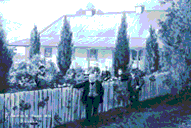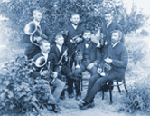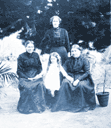 |
 |
 |
 |
 |
Preliminary Phylogenetic Analysis of Briese Family Relationships David Briese (updated May 2014)
Summary
A comparison was made of the STR markers on the Y-chromosome of seven individuals bearing the surname Briese. Based on paper records, two of these individuals were known to be related, but relationships could not be determined for others. The genetic study showed that five of the seven did have a common ancestor within genealogical time and suggests that a cluster of related Briese families lived in the Deutsch Krone area of West Prussia in the 18th century. A sixth individual, originating from a different geographic region, Meseritz in Posen, was more distantly related, while the seventh was not related at all. While not providing proof, these findings agree with the hypothesis that the Briese surname originated as a “place name” that was initially adopted by unrelated people. This would result in distinct clusters of more-closely related families, genetically distinct from other such clusters. Genetic genealogy can help to determine relationships between emigrant Briese families and those remaining in Germany. More individuals from Briese families with known origins are needed to participate in this study to confirm and enlarge on these preliminary findings.
Introduction
The Briese surname 1, as considered here, is of German origin. It is a “place name”, that is when people began adopting surnames in the 15th and 16th centuries, they took the name of the place where they lived. The distribution of the Briese surname during the 17th to 19th centuries is shown in Fig. 1. It shows that the Briese heartland lies in the former Prussian provinces of Brandenburg, West Prussia and Posen, with a pocket occurring in East Prussia and a scattering in the west of Germany. This heartland area has many towns and villages bearing the name Briese, Briesen, or variants of this, and these are likely sources of the surname. More detail of the origins of the name can be found elsewhere 1.
The “place name” origin of the surname would suggest that unrelated people could have initially adopted the name Briese. As families grew and moved, it is hypothesised that this would lead to clusters of related family groups, differentiated from other such clusters, but all bearing the surname Briese. Classical genealogical research indicates that such geographic Briese clusters existed in the late 18th and 19th centuries in Brandenburg, West Prussia, East Prussia, Pomerania and Posen 2,3,4 (see Table 1). However, subsequent internal movement, emigration overseas and displacement due to war has destroyed much of this demographic pattern.
During the 19th century, a number of Briese families emigrated from these areas to North America, Australia and Brazil 5. Many of the descendants of these families are now interested in discovering their family roots and whether their Briese family is related to other Briese families. Paper records provide some answers, but in many cases, these are missing, have critical gaps, or do not go back far enough to provide the evidence needed. As both the surname and the Y-chromosome are passed down the male lineage of a family, genetic genealogy provides a complementary approach that can help unravel the answers to these questions.
This paper describes a study, set up in 20116 to describe the phylogenetic relationships between people bearing the surname Briese, based on the comparison of genetic markers on male Y-DNA. The results of such a study could also clarify conjecture on the origins of the Briese name. Fig.1. Locations where the Briese surname appears in birth, death and marriage records from the 18th and early 19th century 2,3,4,15. The borders of the former eastern part of Prussia are shown in pink.
Table 1. Regions of Prussia with relatively high densities of the Briese name during 18th and early 19th century records.
Methods
Raw data
To date, seven individuals with the surname Briese have contributed Y-DNA samples for analysis. These individuals descend from families that migrated to North America and Australia and, in all but one case, can trace their family back to a specific location in Prussia. Genetic analyses were carried out by FTDNA (Family Tree DNA) 7. The recommended test for 37 STR (short tandem repeat) markers on the Y-chromosome was used, as the 12- and 25-marker sets offered are insufficient to determine relationships as accurately as required.
Individuals participating in this study are identified here by a 6-letter code to protect privacy. The code also identifies the location of the place where the earliest known ancestor of each individual lived (see Table 2). An example of an individual data set of 37 STR markers is shown in Table 3.
Table 2. Explanation of the geographic identity code (all regions are former parts of Prussia or neighbouring areas).
N.B a final number distinguishes individuals originating from the same location, where required e.g. Po-WiPo1 = Posen, Witkowo, Potrzymowo, person 1
Table 3. De-identified data from the FamilyTreeDNA analysis of 37 STR markers on the Y-chromosome (coloured values show mutations).
Network Analysis
Network analysis provides a useful means of visualising the pattern of DNA mutations between individuals or groups. McGee’s on-line Y-DNA Comparison Utility 8 was first used to determine the modal haplotype (a prediction of the ancestral marker set from which measured individuals have diverged) for the seven sets of 37 STR markers. This raw DNA data (see Table 2) was then analysed using the open source software package Network 4.162 (Fluxus Engineering) 9 to show those STR markers that have mutated from the ancestral haplotype, the pattern of divergence of individuals from this modal value and the relative positions of individuals to one another.
Genetic distances and phylogenetic tree
McGee’s Y-DNA Comparison Utility 8 was also used to produce a matrix of genetic distances (the total number of differences, or mutations, between two sets of results) based on the hybrid model used by FTDNA to calculate genetic mutations. This uses the stepwise mutation model for all alleles except DYS464 and YCA which use the infinite allele model 8. Using a mutation rate of 0.054 per generation (the average value derived from all FTDNA data), these data were then used to estimate the time to the most recent common ancestor (TMRCA) in numbers of generations. Individuals Po-WiPo1 and Po-WiPo2 are known to be related with 4 and 5 generations separation, respectively, from their most recent common ancestor and this was used to further calibrate the results.
TMRCAs were further analysed by the Kitsch program of Phylip 10 (version 3.69), a freeware package of phylogenetic software. This program used the Fitch-Margoliash distance matrix method (with molecular clock) to generate the tree structure, showing the phylogenetic relationships of the seven individuals and, by inference, their families. The tree was drawn using the median-joining method of the open source genetic analysis package Mega6 11.
A time-line for the phylogenetic tree was then estimated, based on a generation time of 34 years (the median paternal generation interval of the project participants, going back to their most distant known ancestor (n=26)). This enabled the tree to be shown on two scales, the indicative number of generations back to the point when family lineages separated, and a calendar year time-line, which indicates when such separation may have occurred.
Results
Network Analysis
The results of the network analysis are shown in Fig. 2, which includes the whole network generated for the seven individuals and an enlargement of the nodal area. The network indicates that the unrelated individual (PR) is separated from a grouping formed by the remaining six. The pattern of this cluster (see enlargement) is suggestive that there could be further sub-division. Po-WiPo1 has a STR marker set that is identical to the modal haplotype. He is also known to be related to Po-WiPo2 from paper records, who together with GP-KoSo, Wp-DKNg and Wp-DKAp all lie within 1-2 mutations of the modal haplotype. These form a putative grouping of more closely related individuals and define the “Deutsch Krone” cluster, based on a region in West Prussia which in the 18th-19th centuries had a relatively high density of Briese surnames 12. Po-MeMe, who originates from a different region, deviates from the modal value by four mutations and is less closely related to those within the cluster.
Genetic distances and the phylogenetic tree
The matrix of genetic distances between pairs of Briese individuals is shown in Table 3. According to the FTDNA interpretation of genetic distance 13, a distance of 1 indicates a tight relationship, 2-3 indicates that they are related, 4 indicates a probable relationship, 5 a possible relationship and 6 or more suggests relationships may pre-date the time when people in Europe adopted surnames.
Table 3. Matrix of genetic distances between pairs of Briese individuals (1-3 = related, 4-5 = probably related)
Given that Po-WiPo1 and Po-WiPo2 are from the same family originating from Potrzymowo, Posen, it is not surprising that the genetic distance is so close (=1). This family has been in Australia since 1855. However, these two are also genetically close (distances = 2-3) to the two individuals originating from Deutsch Krone, Westpreussen (Wp-DKNg and Wp-DKAp). The family of Wp-DKNg emigrated to Australia and the family of Wp-DKAp emigrated to the USA. No connection had been found between these three families in paper records (births, deaths and marriages), but the y-DNA evidence demonstrates that they have a relatively recent common origin. The times to the most recent common ancestor of pairs of individuals indicate that were part of a common family about seven generations ago. A fourth family line, GP-KoSo which emigrated from nearby Sompolno to the United States, also forms part of this related cluster (distances = 1-3).
Po-MeMe, originating from Meseritz, Posen, and now based in the USA, is genetically more separated from this group (distances = 4-6) and, when individual pairs are considered, borders on the limit of what FTDNA considers evidence for a relationship. However, the results need to be interpreted in terms of the overall pattern of genetic distances (see Fig. 3). The phylogenetic tree in Fig. 3 suggests that the split between the Meseritz family and the others occurred around 15 generations ago, i.e. in the early 16th century.
The last individual, from a family that emigrated to the
USA, but of unknown origin (other than Prussia), is clearly unrelated to the
other five in genealogical time, showing very large genetic separation from
them (distances = 15-18) and belonging to a different haplogroup (R1a) than
members of the cluster (R1b).
Discussion
A sample size of seven is small and, as a result, findings should be viewed as indicative. That said, the results have shown that genetic studies can make an important contribution to genealogy. They show that five of the individuals, two from Potrzymowo, Posen, two from Deutsch Krone, West Prussia (from the villages of Appelwerder and Neugolz, respectively) and one from Sompolno in Greater Poland, belong to a related cluster of Brieses, which was not demonstrable from paper records. The Y-DNA data also indicate that the common ancestor lived in the late 17th or early 18th century. Church records from the Lüben Evangelical Parish 14 show that there were a large number of Brieses in the Deutsch Krone district, as far back as the mid 18th century. By contrast, the related Briese family from Potrzymowo is the only one in the Czerniejewo Evangelical Church Records 15. This suggests that the family may have moved to that area from Deutsch Krone just prior to the dates of surviving paper records. With local movements such as these, geography alone does not define a family cluster.
The individual originating from Meseritz also appears to be related to the Deutsch Krone cluster, but more distantly, dating back perhaps to the 16th century. Given the large number of Briese records in the Meseritz church book 2,13 in the 18th and 19th century, it seems likely that this region comprises a distinct cluster of Briese families. Further testing of individuals originating from Meseritz is needed to verify this. The Deutsch Krone Brieses could originate from Meseritz, or both clusters might originate from a common ancestor who lived in another region. Again more samples are needed to explore these possibilities.
As for the unrelated individual, there are two possibilities; 1) he is descended from an ancestor who independently took on the name Briese when surnames were being adopted, or 2) the surname lineage and genetic lineage have become disjunct at some stage during the generations elapsed (e.g. in the case of adoption). As before, more samples might provide evidence that this is an independently-originating and unrelated group of Briese families, as might be expected when the surname is derived from a place name. In the case of the second possibility, a unique origin for the Briese surname cannot be discounted.
These results demonstrate that genetic genealogy is able to prove (or disprove) relationships between families where paper records are missing. Several families from the Deutsch Krone area, other than those mentioned here, emigrated to Australia 16 and North America 5 and Y-DNA comparisons of their members should show how they are related. Broader sampling of Briese families from other areas should also be able to show whether the different clusters have originated independently or not. In the latter case, it should be able to show the patterns in related family clusters of a diverging lineage from a distant common ancestor. More sampling is needed to clarify the relationships within family clusters and also the broader patterns of kinship between Briese families originating from different geographic regions.
Acknowledgments
I would like to thank the participants in the Briese surname project, not only for providing DNA samples but for genealogical information about their respective lineages. Thanks are also due to Gail Tonnesen, who founded the Briese surname project and transcribed the records of the Lüben Evangelical Parish from microfilms held by the Family History Library in Salt Lake City, Utah.
Notes and references
|
||||||||||||||||||||||||||||||||||||||||||||||||||||||||||||||||||||||||||||||||||||||||||||||||||||||||||||||||||||||||||||||||||||||||||
This site powered by The Next Generation of Genealogy Sitebuilding ©, written by Darrin Lythgoe 2001-2024.



